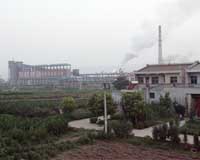| . |  |
. |
Beijing (AFP) Aug 26, 2009 A pair of lead poisoning scandals affecting at least 2,000 children in China are just the latest in a seemingly endless string of pollution scares exposing the dark side of the nation's economic boom. China's growth rates have long been envied around the globe, but its three-decade industrial expansion also has turned it into one of the world's most toxic countries. Countless cities are smothered in smog while hundreds of millions of citizens lack access to unpolluted drinking water. Acid rain affects huge swathes of the country and there are regular revelations of public health scares due to factories spewing cancer-causing toxins and other pollutants into the air, water and the food chain. Despite a growing environmental consciousness here, such scares remain rife due to lax enforcement and an overriding focus on industrial growth, activists said. "The main issue is that local law enforcement remains very weak. They have limited resources to monitor industries, so (polluting) companies can just get away without punishment," said Ma Tianjie, a campaigner with Greenpeace China. In the recent cases, at least 2,150 children living near two smelting plants in Hunan and Shaanxi provinces are suffering from suspected lead poisoning, according to official figures. The plants have been closed. While such cases have grabbed headlines, the true extent of such scandals remains unknown due to a culture of suppressing potentially embarrassing information about pollution, Greenpeace's Ma said. "It's highly possible there are many similar cases out there that just have not been revealed," he said. Campaigners note hopeful signs, including a six-year-old regulation requiring environmental impact assessments and public participation before new industrial projects are approved. Beginning last year, China also started requiring local governments to regularly disclose key environmental information to the public. "That is good news. Affected people have the right to know what it going on," said Ma Jun, who runs the independent Institute of Public and Environmental Affairs in Beijing. But he acknowledged that fulfilling that right would entail a sea change in how China's secretive Communist Party-dominated governance system actually operates. For example, a 2007 World Bank report said 750,000 Chinese die prematurely each year due to air and water pollution -- a figure edited out of final versions of the report, reportedly after China warned it could cause social unrest. Meanwhile, environmental campaigners face continued harassment and even arrest. In one high-profile case, prominent activist Wu Lihong, who fought for years against industrial pollution of a major lake in eastern China, was sentenced to four years in prison in 2007 on fraud charges widely seen as fabricated. Just two years earlier, Wu had been hailed as an "environmental warrior" by the nation's legislature. "Put in a historical perspective, China has come a long way in five years' time on environmental transparency, but it remains quite basic," said Ma Jun. And reports still regularly emerge about projects hustled through by local governments eager for an economic spark -- whatever the environmental costs. "Central government priorities may have shifted, but getting vested interests at the local level to go along is not an easy task," Ma Jun said. In a symbol of the power of such vested interests, China in 2007 postponed plans to factor environmental damage into gross domestic product performance -- the so-called "Green GDP" push -- due to resistance in the provinces, state media said at the time. Share This Article With Planet Earth
Related Links Our Polluted World and Cleaning It Up
 China poisoning victims in hospital, two weeks on
China poisoning victims in hospital, two weeks onChangsha, China (AFP) Aug 24, 2009 Two weeks ago, Xiao Fengying travelled seven hours by car with her two sick children aged six and 13 from their home in China's rural Hunan province to Changsha city for medical treatment. Both were suffering from suspected lead poisoning caused by a smelting plant near their village. Seventeen children from their area, aged 10 months to 14 years, are living in the hospital here as doctors ... read more |
|
| The content herein, unless otherwise known to be public domain, are Copyright 1995-2009 - SpaceDaily. AFP and UPI Wire Stories are copyright Agence France-Presse and United Press International. ESA Portal Reports are copyright European Space Agency. All NASA sourced material is public domain. Additional copyrights may apply in whole or part to other bona fide parties. Advertising does not imply endorsement,agreement or approval of any opinions, statements or information provided by SpaceDaily on any Web page published or hosted by SpaceDaily. Privacy Statement |